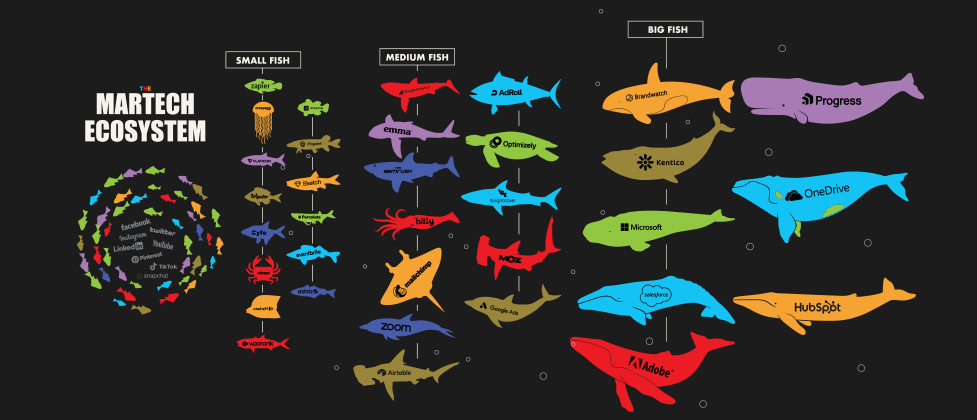MarTech, otherwise known as Marketing Technology, is the term for the software and tech tools marketers leverage to plan, execute and measure marketing campaigns.
A MarTech stack typically consists of a few core tools, although the number and type of specific tools used will vary from company to company, and project to project. A complete MarTech stack should address every stage of the marketing cycle: attracting, engaging, converting, managing and understanding your target customer. Some companies have complex MarTech stacks, while others rely on the essentials.
The number of available MarTech tools has grown exponentially over the last 10 years, currently topping out around 7,500 available products according to Scott Brinker at Chief Martec – and that number continues to grow. The ever-evolving digital landscape means modern marketers must be strategic about how they choose their MarTech stack and understand that marketing is no longer set in stone – it is a living entity that must be continuously evaluated and fine-tuned in order to optimize output.
While marketing tools used to be monoliths that would try and address all marketing automation within a single system, most marketers now are looking for “best-in-class” tools that will seamlessly fit into an existing ecosystem.
What’s the best way to update your MarTech stack? First, understand the types of MarTech products available to us.

How to Start
It’s important you determine exactly how you plan to use marketing automation before selecting where to use tools.
First, chart out your existing marketing funnel, both technical and non-technical. Once you understand your processes and funnel, it will be easier to identify which tools might be right for you. As you’re ascertaining that, ask yourself these questions:
- Are there any gaping holes?
- What is taking up most of your time?
- Where would a tool be the most impactful?
- Where are your pain points?
Generally speaking, MarTech tools are excellent at replacing repetitive tasks. Are there any tasks like this that take up a large portion of your time? Are there any points that are ripe for automation, such as generic emails or data collection?
Automating these types of tasks can save you a lot of time — and in many cases, a marketing automation tool can perform more efficiently than a human. As machine learning and AI become more developed, automating parts of your marketing funnel will mean faster, more accurate data.
Once you have an idea of where tools could best help compliment your existing marketing funnel, the next step is choosing a tool or system.
How to Evaluate Tools
Worldwide, MarTech is a $121.5 billion dollar industry, according to Brinker. With so many solutions for marketers, finding the right tools for your team can be a daunting task. Here are the primary questions to consider when evaluating new tools.
Impact:
The system’s impact on helping a company achieve its marketing objectives?
The tools you first evaluate should be the most impactful for your team. Try and determine how much each tool will effect marketing process and go after low hanging fruit first.
Control:
How much time and resources are spent using the tool?
If you’re considering adopting a system that replaces a large portion of your marketing funnel, make sure you understand the amount of time and manpower needed to implement the new system and fully utilize its capabilities.
Implementation:
How well the will the system’s capabilities be leveraged by the team?
Don’t purchase a highly technical tool that will chiefly be used by non-technical designers. Make sure the product that you’re evaluating will match the general skillset of the primary users. Also consider how much friction will be involved in adoption of the system itself – will there be a large learning curve from what your team is currently doing?
Integration:
How well does the system integrate to existing tools?
A tool or software may have incredible capabilities, but have a hard time integrating into your existing stack. Make sure the tool either has the ability to play nice with your other operational tools, or that it’s worth it to have to build out a custom integration in order for them to communicate.
Investment:
How much of your marketing budget will be allocated to this tool?
If a tool costs 50% of your MarTech budget but only does 5% of the work, it may be time to look for other solutions. This also goes for tools that are “free” – even if a tool is free now, what is the increase in price if your company ends up growing? Be sure to look at the next level cost.

While it will take time and patience to update your MarTech, in the long run it means saving yourself time and money. Q1 is a great time to conduct a MarTech assessment. If you’re interested in MarTech but don’t know where to start, feel free to reach out to us. We can work with you step-by-step to take your stack to the next level.
